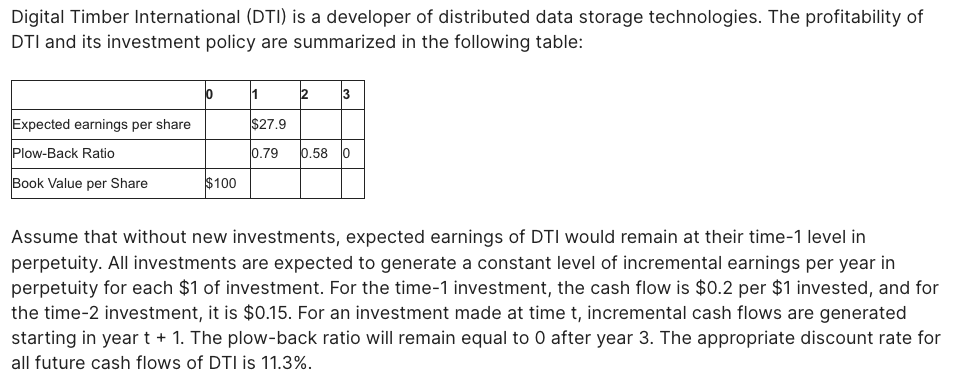Digital Timber International (DTI) is a developer of distributed data storage technologies. The profitability of DTI and its investment policy are summarized in the following table: Expected earnings per share Plow-Back Ratio Book Value per Share b $100 1 $27.9 0.79 0.58 0 2 3 Assume that without new investments, expected earnings of DTI would remain at their time-1 level in perpetuity. All investments are expected to generate a constant level of incremental earnings per year in perpetuity for each $1 of investment. For the time-1 investment, the cash flow is $0.2 per $1 invested, and for the time-2 investment, it is $0.15. For an investment made at time t, incremental cash flows are generated starting in year t + 1. The plow-back ratio will remain equal to 0 after year 3. The appropriate discount rate for all future cash flows of DTI is 11.3%.
Digital Timber International (DTI) is a developer of distributed data storage technologies. The profitability of DTI and its investment policy are summarized in the following table: Expected earnings per share Plow-Back Ratio Book Value per Share b $100 1 $27.9 0.79 0.58 0 2 3 Assume that without new investments, expected earnings of DTI would remain at their time-1 level in perpetuity. All investments are expected to generate a constant level of incremental earnings per year in perpetuity for each $1 of investment. For the time-1 investment, the cash flow is $0.2 per $1 invested, and for the time-2 investment, it is $0.15. For an investment made at time t, incremental cash flows are generated starting in year t + 1. The plow-back ratio will remain equal to 0 after year 3. The appropriate discount rate for all future cash flows of DTI is 11.3%.
Chapter11: Capital Budgeting Decisions
Section: Chapter Questions
Problem 8TP: Fenton, Inc., has established a new strategic plan that calls for new capital investment. The...
Related questions
Question
(a) Compute the expected book value per share at time 1.
(b) Compute the expected earnings per share of DTI at time 2.
(c) Compute the expected value of the ex-dividend stock price at time 2.
(d) Compute the expected value of the ex-dividend stock price at time 0.
(e) Compute the expected return (over a single-period) on the stock of DTI at time 0 (in %).

Transcribed Image Text:Digital Timber International (DTI) is a developer of distributed data storage technologies. The profitability of
DTI and its investment policy are summarized in the following table:
Expected earnings per share
Plow-Back Ratio
Book Value per Share
0
$100
1
$27.9
0.79 0.58 0
2 3
Assume that without new investments, expected earnings of DTI would remain at their time-1 level in
perpetuity. All investments are expected to generate a constant level of incremental earnings per year in
perpetuity for each $1 of investment. For the time-1 investment, the cash flow is $0.2 per $1 invested, and for
the time-2 investment, it is $0.15. For an investment made at time t, incremental cash flows are generated
starting in year t + 1. The plow-back ratio will remain equal to 0 after year 3. The appropriate discount rate for
all future cash flows of DTI is 11.3%.
Expert Solution
This question has been solved!
Explore an expertly crafted, step-by-step solution for a thorough understanding of key concepts.
Step by step
Solved in 5 steps

Knowledge Booster
Learn more about
Need a deep-dive on the concept behind this application? Look no further. Learn more about this topic, finance and related others by exploring similar questions and additional content below.Recommended textbooks for you

Principles of Accounting Volume 2
Accounting
ISBN:
9781947172609
Author:
OpenStax
Publisher:
OpenStax College

EBK CONTEMPORARY FINANCIAL MANAGEMENT
Finance
ISBN:
9781337514835
Author:
MOYER
Publisher:
CENGAGE LEARNING - CONSIGNMENT

Intermediate Financial Management (MindTap Course…
Finance
ISBN:
9781337395083
Author:
Eugene F. Brigham, Phillip R. Daves
Publisher:
Cengage Learning

Principles of Accounting Volume 2
Accounting
ISBN:
9781947172609
Author:
OpenStax
Publisher:
OpenStax College

EBK CONTEMPORARY FINANCIAL MANAGEMENT
Finance
ISBN:
9781337514835
Author:
MOYER
Publisher:
CENGAGE LEARNING - CONSIGNMENT

Intermediate Financial Management (MindTap Course…
Finance
ISBN:
9781337395083
Author:
Eugene F. Brigham, Phillip R. Daves
Publisher:
Cengage Learning